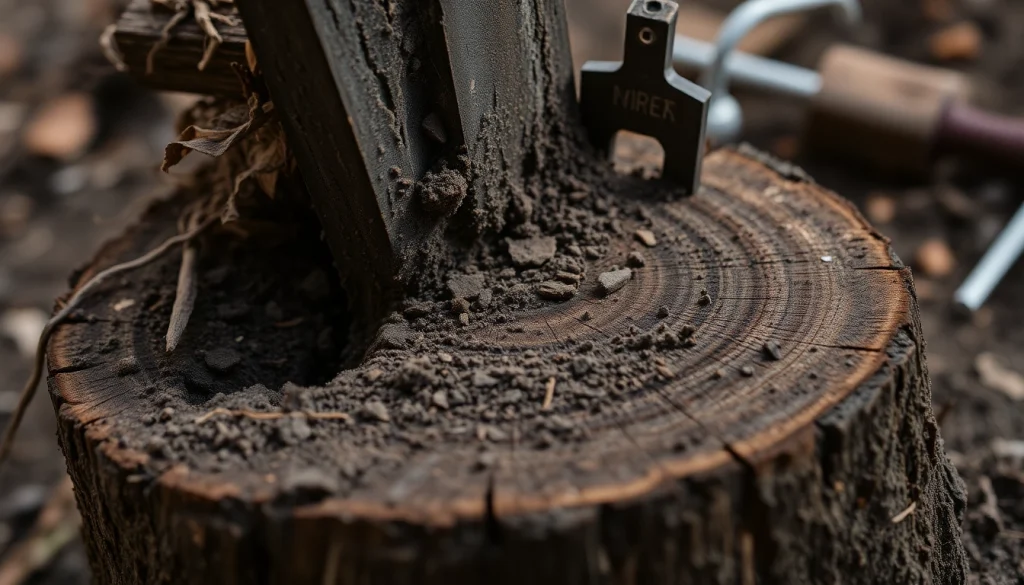
Understanding Stump Grinding Services
What is Stump Grinding?
Stump grinding is the process of mechanically removing tree stumps after a tree has been felled. This service involves using a specialized machine, known as a stump grinder, to reduce the stump to wood chips and mulch. The grinder has sharp blades that spin rapidly, enabling it to grind the stump into small pieces down to several inches below ground level. This allows for the area to be reused for landscaping, planting, or simply to enhance the aesthetic appeal of your yard.
Benefits of Using Professional Services
Engaging a professional stump grinding service offers numerous advantages over attempting a DIY approach. Firstly, professionals bring experience and expertise to the job, ensuring that the stump is removed efficiently and safely. Additionally, they utilize advanced equipment that may not be accessible to the average homeowner, which can significantly speed up the process and minimize the risk of accidents. Furthermore, professional services offer peace of mind, as they are typically insured and follow safety regulations to protect both the workers and the homeowner.
Common Stump Grinding Techniques
There are several techniques employed by professionals when it comes to stump grinding. The most common method involves using a stump grinder to grind the stump down into small pieces. This is often followed by filling the hole with soil or mulch to encourage new growth. Alternative methods may include chemical treatments that speed up the natural decomposition of the stump or the use of manual tools for smaller stumps, although these approaches can be more labor-intensive and less effective in the long run.
Choosing the Right Stump Grinding Service
Key Factors to Consider
When selecting a stump grinding service, several key factors should be taken into account. Firstly, it is essential to consider the company’s experience and reputation in the industry. Companies with a long track record and positive reviews from past clients are often a safer choice. Secondly, evaluate the type of equipment they use. Advanced and well-maintained equipment can lead to faster and safer operations. Lastly, it is wise to confirm that they have proper insurance and certifications to protect yourself from any potential liabilities.
Questions to Ask Potential Services
Before hiring a stump grinding service, consider asking the following questions:
- What experience do you have with stump grinding?
- Can you provide references or testimonials from previous clients?
- What equipment will you use, and is it well-maintained?
- What is your insurance coverage?
- Can you provide a written estimate or quote?
These questions will help you gauge their level of professionalism and ensure that you are making an informed decision.
Reading Customer Reviews Effectively
Customer reviews can offer invaluable insights into the reliability and quality of a stump grinding service. Look for reviews that highlight the timeliness of service, the professionalism of the staff, and the quality of the outcome. Pay attention not only to the overall rating but also to recurring themes in customer feedback. This will provide a balanced view and help you to identify any red flags before making your choice.
The Stump Grinding Process Step-by-Step
Preparing for the Job
Preparation is crucial for a successful stump grinding process. Before the job begins, the area should be cleared of any debris, rocks, or obstacles that could impede the grinding machine. The stump should also be assessed for its size and condition, as larger or rotting stumps may require additional equipment or techniques.
Safety Measures During Grinding
Safety is paramount during stump grinding operations. Professional services adopt various measures to minimize risk, including wearing protective gear such as helmets, goggles, and gloves. Additionally, they ensure that bystanders are kept at a safe distance, and the machine is operated according to manufacturer guidelines. It’s also important to check for underground utilities in the area before commencing work to avoid damaging them.
Post-Grinding Clean Up
Once the grinding is complete, there is usually a considerable amount of wood chips and debris left behind. The cleanup process involves removing excess chips, filling the hole with soil or mulch, and assessing any additional landscaping requirements. Maintaining a clean work site not only enhances the appearance of your yard but also helps prevent any future hazards.
Cost Factors of Stump Grinding Services
Average Cost Estimates
The cost of stump grinding services can vary widely based on several factors, but on average, homeowners can expect to pay between $75 and $300 per stump. The final price often depends on the stump’s size, the complexity of the job, and the specific service provider. For instance, larger stumps or those located in challenging areas may incur higher costs due to the increased labor and equipment required.
Factors Influencing Pricing
Several factors can influence the cost of stump grinding. These include:
- Size of the Stump: The larger the stump, the more time and equipment will be required to grind it down.
- Location: Accessibility to the stump plays a significant role; stumps in hard-to-reach areas may increase labor costs.
- Root Depth: Deeper roots require additional grinding and may extend the time needed, thus affecting pricing.
- Hazardous Conditions: If there are nearby structures or utilities, special precautions might add to the overall cost.
Budgeting for Additional Services
It’s wise for homeowners to budget for potential additional services post-grinding. This may include soil amendment for new plant growth, landscaping services, or even tree planting in the area where the stump once stood. Understanding the complete scope of work and its associated costs will allow for better financial planning and a more satisfactory outcome for your property.
Maintaining Your Landscape After Stump Removal
Soil Health and Fertilization
After stump removal, it is crucial to focus on soil health in the affected area. The decomposition of the stump can lead to nutrient-poor soil, so it’s advisable to perform a soil test to check for any deficiencies. Based on the results, you can apply the appropriate fertilizers or organic amendments to enrich the soil. This will help foster a productive environment for new plant growth and maintain overall landscape health.
Planting Options for Former Stump Areas
Once the stump is removed and the soil is prepared, you have various options for planting in that area. Some ideas include:
- Flowers: Annuals and perennials can thrive in newly prepared soil, adding color and vibrancy.
- Grass: Specific varieties of grass can help restore the lawn and fill the bare spot left by the stump.
- Trees or Shrubs: Depending on your landscape design, you might consider planting a new tree or decorative shrub in that location.
Choosing the right plants will ensure that the area looks naturally integrated into your landscape.
Long-Term Landscaping Tips
To maintain and enhance your landscape after stump removal, consider implementing the following long-term strategies:
- Regular Maintenance: Ensure that you routinely check and care for your plants, including watering, pruning, and fertilizing as needed.
- Mulching: Adding a layer of mulch can help retain moisture in the soil and suppress weeds while enhancing visual appeal.
- Landscaping Design: Consult with a landscape designer if you’re considering major landscaping projects, ensuring a cohesive aesthetic throughout your yard.
- Sustainability Practices: Incorporating environmentally friendly practices, such as composting and organic gardening, can improve soil health and contribute to a thriving landscape.






